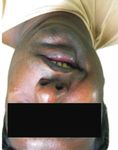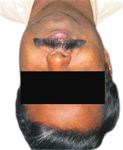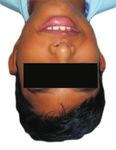Dynamic smile reanimation in facial nerve palsy - Journal of ...
←
→
Page content transcription
If your browser does not render page correctly, please read the page content below
https://doi.org/10.5125/jkaoms.2020.46.2.143
CASE SERIES STUDY pISSN 2234-7550 · eISSN 2234-5930
Dynamic smile reanimation in facial nerve palsy
Krishnakumar Krishnan Santha1, Subin Joseph2, Sameer Latheef2, Saju Narayanan1,
Santhy Mohanachandran Nair2, Bibilash Babu1, Anand Sivadasan2, Srivatsa Manjunath Shet2,
Rajesh Vardhan Pydi2, Ajit Pati1, Srikant Aruna Samantaray2
1
Department of Plastic and Reconstructive Surgery, Aster MIMS Hospital,
2
Department of Plastic, Reconstructive and Burns Surgery, Baby Memorial Hospital, Kozhikode, India
Abstract (J Korean Assoc Oral Maxillofac Surg 2020;46:143-149)
Objectives: Long-term facial paralysis results in degeneration of the distal nerve segment and atrophy of the supplied muscles. Options for these pa-
tients include free muscle transfer, temporalis myoplasty, and botulinum toxin injections for smile reanimation. In this study we aimed to evaluate the
subjective and objective outcomes of these procedures.
Materials and Methods: In our study, we retrospectively analyzed smile symmetry in patients with facial palsy (n=8) who underwent facial reani-
mation procedures.
Results: Subjective analysis showed high satisfaction in seven out of eight patients. Objective analysis showed statistically significant improvement
postoperatively in both vertical and horizontal smile symmetry at rest and during maximum smile (PJ Korean Assoc Oral Maxillofac Surg 2020;46:143-149
tion. Subjective outcome assessment was done as per the to the chin point. Another line was drawn parallel to the verti-
questionnaire (Table 1) described by Sassoon et al.8 with few cal line joining the lowest point of cupid’s bow and IPL. The
modifications. delta horizontal (DH) value was calculated as the distance
Objective assessment was conducted using the pre- and between these two vertical lines.(Fig. 1) Separate horizontal
postoperative photographs at rest and during smile. The verti- lines were drawn to connect the commissures to the midline
cal and horizontal smile symmetry were assessed for each vertical. The distance between these two horizontal lines was
patient. Photographs were initially standardized by compar- calculated as the delta vertical (DV). Finally, the DH and DV
ing white to white iris diameter against the standard human were standardized as a real scale using multiplication factors.
reference value9 of 11.7 mm to obtain a multiplication fac- Statistical analysis of the quantitative data was performed
tor10 using Adobe Photoshop CC v20 (Adobe, San Jose, CA, using the IBM SPSS Statistics software v25 (IBM Corp.,
USA). An inter-pupillary line (IPL) was drawn and from the Armonk, NY, USA). Means were compared using a paired t-
midpoint of the IPL, a perpendicular line was dropped down test for both DH and DV at rest and during maximum smile11.
1. Operative technique
Table 1. Subjective assessment questionnaire
No. Parameter assessed
1 How concerned were you Highly concerned 1) Free muscle transfer
before surgery? Fairly concerned After informed consent, the patient was counseled about
2 How satisfied are you after Highly satisfied
surgery? Fairly satisfied realistic expectations and achievable goals. The surgery was
Unsatisfied done in a single stage. A parotidectomy incision (lazy S) with
3 How much improvement in Greatly improved
facial symmetry have you Slightly improved extension to the submandibular region was used to expose
noticed at rest? the paralyzed side of the face. The skin flap over the parotid-
4 How much improvement in Greatly improved
Slightly improved
masseteric fascia was dissected until the orbicularis muscle
facial symmetry have you
noticed during smile? of the lips on the affected site was visualized. Another inci-
5 Will you recommend this Yes sion was made on the normal side, 1 cm above and parallel to
to similar patients? No
Krishnakumar Krishnan Santha et al: Dynamic smile reanimation in facial nerve palsy. J
the nasolabial crease and facial nerve branches were identi-
Korean Assoc Oral Maxillofac Surg 2020 fied. On stimulation, the branch which produced upward and
IPL
DH
Fig. 1. Objective assessments of pre-
operative (A) and postoperative (B)
DV photographs. (IPL: inter pupillary line,
DH: delta horizontal left right arrow, DV:
delta vertical up down arrow)
Krishnakumar Krishnan Santha et al: Dynamic smile
A B reanimation in facial nerve palsy. J Korean Assoc
Oral Maxillofac Surg 2020
144Dynamic smile reanimation in facial nerve palsy
Fig. 3. Temporalis muscle with fascial slings.
Fig. 2. Harvested free gracilis muscle with neurovascular pedicle.
Krishnakumar Krishnan Santha et al: Dynamic smile reanimation in facial nerve palsy. J
Krishnakumar Krishnan Santha et al: Dynamic smile reanimation in facial nerve palsy. J
Korean Assoc Oral Maxillofac Surg 2020
Korean Assoc Oral Maxillofac Surg 2020
lateral movement of the angle of mouth and upper lip, was stasis was attained and closure was completed over a suction
selected, which is typical for the branches of buccal divi- drain.
sion of the facial nerve. The anterior one-third of the gracilis
muscle and the required muscle length were marked before 3) Botulinum toxin
the muscle was divided. The free gracilis muscle flap was An intramuscular injection of 2 IU of botulinum toxin type
harvested with the neurovascular pedicle in such a way that, B was applied to the upper lip elevators which included the
most of the muscle was distal to the pedicle.(Fig. 2) The flap zygomaticus major, zygomaticus minor, and levator anguli
was positioned over the face so that the motor nerve could oris muscles.
reach the contralateral side after tunneling through the upper
lip. The motor nerve was coapted to the selected facial nerve 2. Postoperative smile therapy
branch and the vascular pedicle was anastomosed to the facial
vessels. Donor and recipient site closures were performed in All patients who underwent temporalis myoplasty were
layers. given temporalis muscle stimulation 1 week following sur-
gery and this was continued for 4 months. All were retrained
2) Temporalis myoplasty to smile after clenching their teeth. Nerve stimulation was
An incision was made in front of the ear, extending to performed for 6 months for the free gracilis muscle transfer
above the temporo-parietal region of the scalp. The tempo- patients, after the cross facial nerve graft. In addition, patients
ralis muscle and deep temporal fascia were identified after were advised by a physiotherapist to complete regular mas-
elevating the skin flap above the superficial musculo-apo- sage and blowing, sucking, puffing and gargling exercises.
neurotic system of the face. A small incision was made at the
angle of the mouth along the vermillion border. A tunnel was III. Results
made in the subcutaneous plane between these two incisions.
The mid-portion of the temporalis muscle was marked and The subject ages group ranged from 4 to 50 years with a
dissected along with deep temporal fascia and pericranium. mean age at surgery of 30 years. Out of these, five patients
Two slips were created by splitting the deep temporal fascia were males and three were females with a sex ratio of 5:3.
overlying the muscle.(Fig. 3) The muscle and the slips were Four patients had congenital facial palsy, one had post-
flipped over the zygomatic arch and tunneled through the traumatic facial palsy and three patients were diagnosed with
subcutaneous plane to reach the oral commissure. The fascial idiopathic facial palsy. Five patients had facial palsy on the
slips were sutured to the orbicularis muscle of the upper and right side and three had palsy on the left side. All patients had
lower lips and the modiolus to maximum tightness. Hemo- more than a three year history of facial palsy. No syndromic
145J Korean Assoc Oral Maxillofac Surg 2020;46:143-149
Table 2. Subjective assessment results
No. Parameter assessed No. of patients (%)
1 How concerned were you before surgery? Highly concerned 7 (87.5)
Fairly concerned 1 (12.5)
2 How satisfied are you after surgery? Highly satisfied 7 (87.5)
Fairly satisfied 1 (12.5)
Unsatisfied 0 (0)
3 How much improvement in facial symmetry have you noticed at rest? Greatly improved 7 (87.5)
Slightly improved 1 (12.5)
4 How much improvement in facial symmetry have you noticed during smile? Greatly improved 6 (75.0)
Slightly improved 2 (25.0)
5 Will you recommend this to similar patients? Yes 8 (100)
No 0 (0)
Krishnakumar Krishnan Santha et al: Dynamic smile reanimation in facial nerve palsy. J Korean Assoc Oral Maxillofac Surg 2020
Table 3. Objective assessment results with associated P -value
Preoperative Postoperative P -value
Delta vertical (mm) At rest 11.29±1.38 3.33±0.51Dynamic smile reanimation in facial nerve palsy
sistent segmental neurovascular anatomy, we harvested just re-innervation is insufficient, creating another cross facial
the anterior one-third of the muscle as a separate motor unit, nerve grafting and muscle transfer are then required. The free
based on patient need which allowed us to avoid the exces- functioning muscle transfer technique can also be problem-
sive bulk. This approach also allows hemostasis before divid- atic due to flap failure, increased theatre time and cost. Pre-
ing the vascular pedicle and prevents hematoma formation. operative and postoperative photos are shown in Fig. 5.
The nerve is usually coapted to the buccal branch of the fa- The lengthening temporalis myoplasty (LTM) approach
cial nerve on the unaffected side, thus enabling a spontaneous was first described by Labbé in 19976. LTM ensures the
symmetrical smile once the re-innervation is complete. This transfer of the temporalis muscle, which is innervated by the
approach does involve a long waiting period, compared to trigeminal nerve, to the upper lip without an interposition of
the temporalis myoplasty, before the final results. Successful aponeurotic tissue. Because of neural plasticity, the tempo-
results depend on whether the free muscle transfer survives ralis muscle changes its function by pulling the angle of the
and depend on whether the muscle re-innervation is sufficient mouth upwards, along the vector of the contraction which
to generate a smile that is symmetrical with the healthy non- produces a smile. The LTM approach is a dynamic treat-
paralyzed side at rest and during smile. If the gracilis muscle ment for longstanding facial paralysis. LTM surgery can be
Fig. 5. Preoperative (A) and three-year
postoperative (B) images showing result
of free functioning gracilis muscle trans-
fer.
Krishnakumar Krishnan Santha et al: Dynamic smile
A B reanimation in facial nerve palsy. J Korean Assoc
Oral Maxillofac Surg 2020
Fig. 6. Preoperativ (A) and one-year
postoperative (B) images showing result
of temporalis myoplasty.
Krishnakumar Krishnan Santha et al: Dynamic smile
A B reanimation in facial nerve palsy. J Korean Assoc
Oral Maxillofac Surg 2020
147J Korean Assoc Oral Maxillofac Surg 2020;46:143-149
Fig. 7. A. Preoperative image showing
synkinesis in left upper lip and nasola-
bial region. B. Postoperative image fol-
lowing botulinum toxin injection.
Krishnakumar Krishnan Santha et al: Dynamic smile
A B reanimation in facial nerve palsy. J Korean Assoc
Oral Maxillofac Surg 2020
completed within one to two hours and similar results can be therefore, rehabilitation must be achieved for all patients. In
achieved, compared to free muscle transfer.(Fig. 6) However, our series we were able to assess outcomes in a small study
even with this approach, it is nearly impossible for such pa- group; however, the small patient population was a limitation,
tients to achieve a spontaneous smile. therefore, further studies are required in a large study group.
Severe post-paralysis synkinesis can be managed easily
with a nonsurgical method like botulinum toxin injection for V. Conclusion
selected muscles, and the injection produces local chemode-
nervation. Injection of botulinum toxin in healthy muscles Even though free functioning muscle transfer is considered
increases the movements of paretic muscles secondary to a as the gold standard procedure, temporalis myoplasty is also
short-term reduction in the force of contraction of muscles on a worthwhile option for patients with facial paralysis, as dem-
the normal side. An intramuscular injection of 2 IU is given onstrated in this series. Botulinum toxin can be confidently
to the affected group of muscles in cases of synkinesis.(Fig. used before or after surgery or even as a single treatment mo-
7) Even though this approach requires repeat injections, it is dality in selected cases. Choosing the ideal procedure for pa-
minimally invasive and greatly improves facial symmetry7. tients is the most critical aspect for facial reanimation. Simi-
Improvement in both dimensions, i.e., vertically and hori- lar to other surgical procedures, postoperative rehabilitation
zontally, is essential for obtaining satisfactory results. Objec- therapy is also an essential component for achieving optimal
tive improvement alone may not always be associated with outcomes.
patient satisfaction, as the satisfaction is always subjective.
However, subjective assessment alone does not quantify ORCID
operative outcomes. Hence a combination of both subjec-
tive and objective assessments were used. In this series we Krishnakumar Krishnan Santha, https://orcid.org/0000-
found that facial reanimation procedures provided good facial 0002-0526-8685
symmetry and all patients were satisfied with the outcomes. Subin Joseph, https://orcid.org/0000-0002-4079-5499
(Table 2) Postoperative DH and DV values indicated great Sameer Latheef, https://orcid.org/0000-0002-3634-656X
improvement and the analytical results indicated that the im- Saju Narayanan, https://orcid.org/0000-0002-4937-8456
provements were statistically significant. The role of nerve Santhy Mohanachandran Nair, https://orcid.org/0000-0002-
and muscle stimulation is crucial in the postoperative period, 3409-6923
148Dynamic smile reanimation in facial nerve palsy
Bibilash Babu, https://orcid.org/0000-0003-0997-5448 reported.
Anand Sivadasan, https://orcid.org/0000-0003-3162-0037
Srivatsa Manjunath Shet, https://orcid.org/0000-0001-8494-8779 References
Rajesh Vardhan Pydi, https://orcid.org/0000-0002-6014-3375
Ajit Pati, https://orcid.org/0000-0002-4533-7534 1. Nduka C, Hallam MJ, Labbe D. Refinements in smile reanimation:
10-year experience with the lengthening Temporalis Myoplasty. J
Srikant Aruna Samantaray, https://orcid.org/0000-0002- Plast Reconstr Aesthet Surg 2012;65:851-6.
5253-5096 2. Ghali S, MacQuillan A, Grobbelaar AO. Reanimation of the middle
and lower face in facial paralysis: review of the literature and per-
sonal approach. J Plast Reconstr Aesthet Surg 2011;64:423-31.
Authors’ Contributions 3. Kumar PA. Cross-face reanimation of the paralysed face, with a
single stage microneurovascular gracilis transfer without nerve
graft: a preliminary report. Br J Plast Surg 1995;48:83-8.
K.K.S. and S.J. conceptualized the study design. S.L., S.N., 4. Niziol R, Henry FP, Leckenby JI, Grobbelaar AO. Is there an ideal
B.B., and A.P. did the literature search. S.J., S.M.N., and A.S. outcome scoring system for facial reanimation surgery? A review
of current methods and suggestions for future publications. J Plast
collected the data. S.J. and S.M.S. wrote the manuscript and Reconstr Aesthet Surg 2015;68:447-56.
statistical analysis. R.V.P. and S.A.S. did proof reading and 5. Sforza C, Frigerio A, Mapelli A, Tarabbia F, Annoni I, Colombo
V, et al. Double-powered free gracilis muscle transfer for smile
bibliography check. S.J. and S.M.S. coordinated and prepared reanimation: a longitudinal optoelectronic study. J Plast Reconstr
final draft. All authors read and approved the final manuscript. Aesthet Surg 2015;68:930-9.
6. Labbé D. [Lengthening of temporalis myoplasty and reanima-
tion of lips. Technical notes]. Ann Chir Plast Esthet 1997;42:44-7.
Acknowledgements French.
7. Salles AG, Toledo PN, Ferreira MC. Botulinum toxin injection in
long-standing facial paralysis patients: improvement of facial sym-
The authors would like to thank Mrs. Shamna, the Depart- metry observed up to 6 months. Aesthetic Plast Surg 2009;33:582-
ment Secretary, and Mr. Vinod the operating room technician 90.
8. Sassoon EM, Poole MD, Rushworth G. Reanimation for facial
for their technical help and illustration of figures. palsy using gracilis muscle grafts. Br J Plast Surg 1991;44:195-
200.
9. Venkataraman A, Mardi SK, Pillai S. Comparison of Eyemetrics
Ethics Approval and Consent to Participate and Orbscan automated method to determine horizontal corneal
diameter. Indian J Ophthalmol 2010;58:219-22.
10. Panciera DT, Sampieri C, Deganello A, Danesi G. Lengthening
This study was approved by the Institutional Ethics temporalis myoplasty: objective outcomes and site-specific quality-
Committee of Baby Memorial Hospital (No. BMH/IEC/ of-life assessment. Otolaryngol Head Neck Surg 2017;157:966-72.
11. Foirest C, Granger B, Gatignol P, Bernat I, Nguyen Y, Lamas G, et
PS/09/2020), and the informed consent was waived.
al. Smile reanimation after unilateral facial palsy by lengthening
temporalis myoplasty: objective and subjective evaluation on 25
cases. Plast Reconstr Surg 2017;139:984e-93e.
Consent for Publishing Photographs
Written informed consent was obtained from the patients
for publication of this article and accompanying images.
How to cite this article: Krishnan Santha K, Joseph S, Latheef
S, Narayanan S, Nair SM, Babu B, et al. Dynamic smile reanima-
Conflict of Interest tion in facial nerve palsy. J Korean Assoc Oral Maxillofac Surg
2020;46:143-149. https://doi.org/10.5125/jkaoms.2020.46.2.143
No potential conflict of interest relevant to this article was
149You can also read



























































